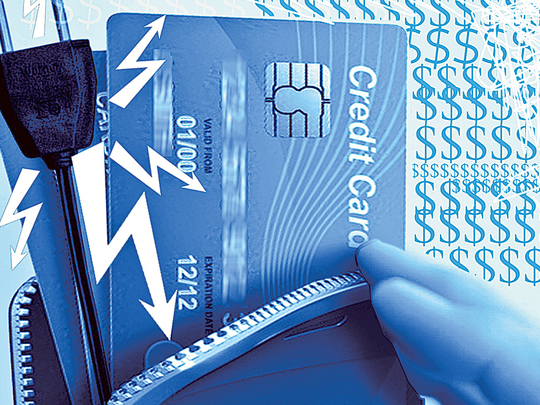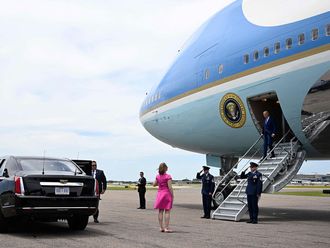
Have you ever had a day where you forgot to take your wallet to the office?
Aside from panicking that you’ve dropped it on the train, you have to cadge money from colleagues to buy coffee and lunch, maybe a bit more to top up your Oyster card — and you can forget about buying groceries after work, a round in the pub or even a taxi home.
A few weeks ago, it struck me that I hadn’t actually brought my wallet to the office for several weeks. Unwittingly, I have become a poster child for Andy Haldane, the Bank of England’s chief economist.
Last week, he argued we should all eschew cash in favour of a government-backed digital currency as this would make it easier to introduce negative interest rates. If we were charged to hold money in the bank, in theory, this could perk up the economy by getting us to spend more.
I don’t blame the Bank of England for weaning me off cash — I blame the FT press office (now there’s a conspiracy theory). It recently gave me a branded “card pouch” to stick to the back of my iPhone which snugly contains my contactless debit card. This has made me see my wallet for what it is — an expensive leather wrapper for cumbersome coins, old receipts and loyalty cards I never use.
Who needs that when you can simply tap a card instead?
In August, the UK Cards Association revealed there had been a 255 per cent annual rise in contactless payments, with 46 million transactions recorded in December 2014. I suddenly thought of myself merrily tapping away on the London Underground, in coffee shops, supermarkets and even pubs. In September, the contactless limit rose to 30 pounds, increasing the temptation to tap.
Since the UK launch of Apple Pay in July, I can also pay by swiping my iPhone. This is already accepted on the Tube and by over 250,000 shops and restaurants, and has been embraced by NatWest and Santander. You can even link your debit card to your iPhone by simply taking a photo of it.
Santander warns that if you use Apple Pay on London Underground, “it’s important the battery on your device will last the journey” to avoid being trapped at the barriers or charged a penalty fare. A first-world problem, if ever I heard one.
But this is not my only virtual transport spending. Where I used to pay cash for a cab, I now summon an Uber car via the app on my phone (no cash is involved, as it’s linked to your bank card). It has never been more convenient for me to spend money — so is it becoming a bad habit?
My bank statements provide a sobering analysis. When you look at individual contactless taps — typically for 6 pounds or so — they don’t seem that bad, but they certainly add up.
Comparing August 2015 to August 2014, the amount of money I spent monthly via contactless transactions increased by a whopping 211 per cent to 170 pounds. For August, I tapped to pay 22 times, up from eight times in August 2014.
The biggest share of my contactless spending — at just over one-third — was swallowed by Pret, Eat and similar coffee and lunch establishments near my workplace. This just pipped Transport for London, though this will be a lot higher for most Londoners as I mostly cycle to work.
Contactless transactions in supermarket convenience stores made up just under one quarter of my spending — although I hate shopping in these as I know their prices are higher — and the remaining 9 per cent was splashed in a pub.
Richard Hyman, the veteran retail analyst, was not surprised by my increased spending. “Even though those are significant numbers in terms of spending, it shows we don’t notice much when things evolve.”
Banks and retailers would love us to ditch cash, he says — it’s expensive to handle, customer data can be gleaned through all those taps, and that data can be leveraged. For example, Lloyds offers customers cash back (through its ‘Everyday Offers’) if you shop in particular stores.
Next, I looked into my journey history on Uber. I knew this would not be pretty: with no car, a social life and three teenagers to ferry around, minicabs are our lifeline. In August I spent 141 pounds, and since I first downloaded the app in November, I’m ashamed to say the average has been 130 pounds a month (though this is still less than paying for a car, insurance, parking, the congestion charge and petrol).
Feeling like I should set up a ‘Contactless Anonymous’ help group, I felt slightly better when I looked at my corresponding monthly cash withdrawals.
In August 2014 I made 10 separate trips to ATMs, withdrawing a total of 600 pounds. This August I withdrew around one-third of that amount — 220 pounds — across just four transactions. This was a relief — but I was still concerned that the ease of spending money on contactless was making me more profligate.
So two weeks ago, I started an experiment: could I survive on cash without using contactless or Uber? And would I spend less? The answer is yes — but it was not easy.
Handing over hard cash (and having to find a cashpoint to withdraw it) definitely reduced the urge to buy on impulse. I cycled (even when it rained heavily) made my own sandwiches and drank less coffee. When I got a Virgin train to Manchester and it was announced that the bar could only accept cash, everyone groaned — but I cheered.
When it came to public transport, however, the queues for Oyster machines were horrific. But overall, I cut my discretionary spending by more than a quarter.
By huge serendipity, Haldane’s “cash-bashing” happened midway through my experiment. Chris Giles, the FT’s economics editor, has argued such a move could shrink the black economy, envisaging a world where drug dealers will be forced to accept euros instead.
I wouldn’t have that problem, but I already pay our cleaner via an app called Hassle, eradicating yet another traditional cash-in-hand transaction.
And I won’t be going back to cash. Contactless is more convenient, though now I’m thinking much more carefully before I tap.
— Financial Times












